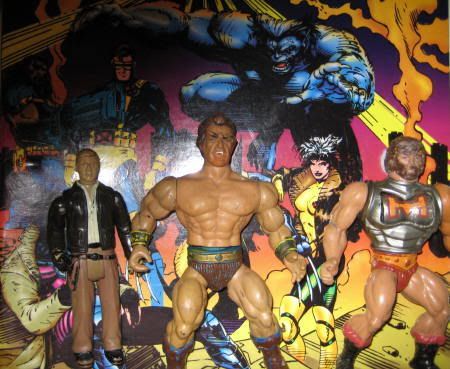
When I was a boy, I would see a movie, read a comic, or some such passive entertainment, then reenact a variation of what I saw using action figures. If I had an Indiana Jones doll in my hands, I would invariably have him take part in adventures in that guise and along the expected lines of fantastic archeology in a period setting. If I had in my hands a toy based on a licensed character I had no real affinity for, like He-Man, he would invariably substitute for a character I did like, but who possessed no such toy, like Conan the Barbarian. Alternately, I would either develop a derivative personality around the toy as a supposedly "new" character, or treat them as a cypher to assume whatever role my afternoon's fiction required (thug, victim, etc.) This is how I learned the fundamentals of storytelling, through naked imitation.
As I aged, I accumulated both more toys and more personal experience to inform my play time. Even when a Wolverine action figure would be produced and purchased, I would have already spent years projecting my interest in that character upon a proxy, who would have had his own adventures separate from his inspiration. Also, various influences would overlap, so that my Conan would team-up with my Wolverine and perhaps be joined by Indiana Jones on a mission against robots sentries in outer space. In my dramas, my Jean Grey proxy would fulfill my desire to see her shacked-up with Wolverine instead of Cyclops, while my Conan might have lost a leg to poor quality control standards at Mattel and become a team leader or a sleuth to compensate. Circumstance and variation would cause my substitutes to become developed characters in their own right, and cause me to focus on their stories as Indiana Jones fell by the wayside. This is how one progresses beyond imitation into actual creation.
Like most teenagers, I wanted to bless the world with my new found powers, which of course meant inflicting my prejudices and ineptitude on other people's creations. Shouldn't all comic books, if they're to be worth reading, be written and drawn in the manner of the creators I liked, and any other tastes be damned? Shouldn't the spotlight always fall on the types of characters I was interested in, with all others serving as fodder in service to their glory? Wouldn't Superman be cooler if he used his incredible strength to karate chop people's heads in two, or Mr. Fantastic could form knives out of his fingers, or the Disco Dazzler could use her light powers to slay vampires? Shouldn't Moon Knight just stomp on Spider-Man for once, and could Booster Gold just die already?
Well, no, obviously. Beyond being terrible, degrading alterations based on sheer lack of merit, they would also afflict existing characters in a manner that would only serve to dismay their creators and fans. Further, new characters created with these same slight "innovations" might be welcomed by fans who would turn away from their being applied to characters with histories previously unpalatable to them, and the preexisting fans would constantly seek to reverse the subversion of character concepts they had embraced before you ruined everything.
That, dear reader, is an extreme example of my theory of seminal integrity in sequential art. It's essentially the golden rule for comic book fantasists working with characters not of their own creation. Do unto others' creations that which you would have done to your own. I'll be discussing this over the next few days...


No comments:
Post a Comment